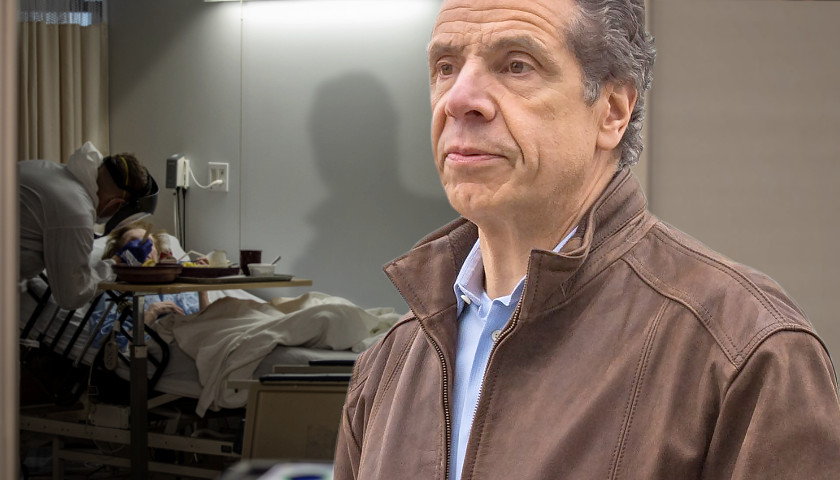by Andrew Kerr
New York has omitted an unknown number of coronavirus deaths in recent reports regarding residents of nursing home and adult care facilities, the New York State Department of Health acknowledged in a statement to the Daily Caller News Foundation.
In early May, those reports quietly began omitting long-term care residents who died of coronavirus in hospitals. Even so, New York still leads the nation with 5,433 reported deaths at nursing homes and adult care facilities as of Wednesday.
 The revelation comes as New York Gov. Andrew Cuomo faces criticism for ordering nursing homes and other long-term care facilities to accept patients from hospitals who had tested positive for coronavirus. Cuomo rescinded the March 25 order, which experts say led to higher levels of death among nursing home residents, on May 11 to allow such facilities to wait until a coronavirus patient tests negative before readmitting them.
The revelation comes as New York Gov. Andrew Cuomo faces criticism for ordering nursing homes and other long-term care facilities to accept patients from hospitals who had tested positive for coronavirus. Cuomo rescinded the March 25 order, which experts say led to higher levels of death among nursing home residents, on May 11 to allow such facilities to wait until a coronavirus patient tests negative before readmitting them.
The NYSDOH confirmed to the DCNF that until around April 28, it was disclosing coronavirus deaths for all nursing home and adult care facility residents, regardless of whether the patient died at their long-term care facility or at a hospital.
But the department made a subtle change to its disclosures beginning around May 3, according to web archives. The NYSDOH told the DCNF its disclosure now only reports coronavirus deaths for long-term care patients that died while physically present at their facility.
New York’s coronavirus tracker “currently does not include out of facility deaths,” NYSDOH spokeswoman Jill Montag told the DCNF. “Deaths of nursing home and adult care facility residents that occurred at hospitals is accounted for in the overall fatality data on our COVID-19 tracker.”
In other words, New York’s nursing home and adult care facility coronavirus deaths tracker omits any individuals who contracted coronavirus while living at a long-term care facility but died in a hospital.
Montag told the DCNF that the state is opting to not disclose out of facility deaths “in order to maintain consistency and reliability in the data as presented, and to avoid any potential for double-counting.”
But the reporting change has, in fact, resulted in inconsistencies in New York’s disclosure of long-term care coronavirus fatalities, particularly regarding deaths of residents of adult care facilities, which don’t typically don’t have the medical capacity of nursing homes or hospitals.
New York reported on April 28 that there had been 644 deaths from residents of adult care facility residents who died at either the facility or at a hospital. Montag confirmed that the table “contained lab-confirmed and, in some cases, presumed COVID-19 deaths.”

But on May 13, after the state ceased disclosing long-term care residents who died at hospitals, New York reported a total of 165 coronavirus-confirmed and presumed deaths at adult care facilities — a reduction of 479 deaths from its disclosure 16 days prior.
Of the nine states with the largest coronavirus outbreaks at long-term care facilities, according to a New York Times tracker, New York is the only state that omits the deaths of residents who died at hospitals from its reporting.
Spokespeople for the health departments of New Jersey, Pennsylvania, Illinois, Maryland and Massachusetts confirmed to the DCNF that their disclosures include coronavirus deaths of long-term care residents regardless of their place of death.
The health departments of California, Connecticut and Georgia all make clear in their reporting that their disclosures of long-term care residents who died of coronavirus includes those who died in hospitals. Connecticut’s reporting of nursing home deaths, for example, specifically “includes residents currently in-house, in the hospital, or who are deceased.”
The NYSDOH did not respond to the DCNF when asked if it disputes that the state is omitting at least 479 adult care facility residents that died from coronavirus at a hospital in its reporting on long-term care deaths.
The department also did not respond when asked what the health benefits are of concealing the deaths of long-term care residents who died in hospitals from its reporting on long-term care coronavirus fatalities.
New York ceased reporting deaths of long-term care residents who died in hospitals the same day it unveiled 1,700 previously undisclosed deaths that occurred on the grounds of long-term care facilities from residents presumed to have coronavirus.
Betsy McCaughey, a former Republican lieutenant governor of New York and current chairman of the patient advocacy group Committee to Reduce Infection Deaths, told the DNCF that New York should rejoin other states and resume disclosing the deaths of all long-term care patients, regardless of whether they died at a hospital.
“It would be a more accurate reflection of the peril at nursing homes,” McCaughey said. “If you look at the more accurate figures reported by other states, it’s reasonable to conclude that half of all deaths in the United States are among nursing home residents and that rather than shutting down the economy they could have focused resources on nursing homes.”
Indeed, of the nine states with the largest coronavirus outbreaks, New York has the lowest reported share of state deaths from long-term care residents at 20%, according to The Times.
The share of long-term care resident fatalities reported by the other eight states ranges from 36% to 66%, according to The Times.
– – –
Andrew Kerr is a reporter for the Daily Caller News Foundation.
Photo “Gov. Andrew Cuomo” by Gov Andrew Cuomo and “Senior COVID Patient” by the Department of Defense.




